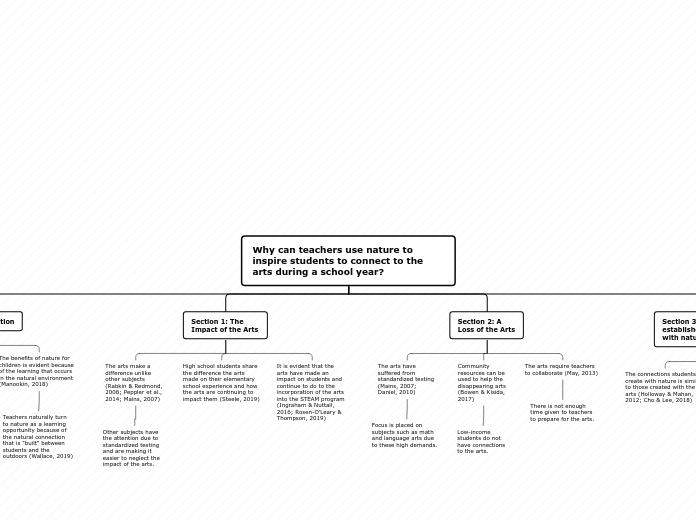Why can teachers use nature to inspire students to connect to the arts during a school year?
Introduction
The arts can be used to inspire students to be environmentally aware and engaged (Inwood, 2013; Robidoux & Kovac, 2018; Malosh, 2010)
It is evident that nature and the arts "align."
The benefits of nature for children is evident because of the learning that occurs in the natural environment (Manookin, 2018)
Teachers naturally turn to nature as a learning opportunity because of the natural connection that is "built" between students and the outdoors (Wallace, 2019)
Section 1: The Impact of the Arts
The arts make a difference unlike other subjects (Rabkin & Redmond, 2006; Peppler et al., 2014; Mains, 2007)
Other subjects have the attention due to standardized testing and are making it easier to neglect the impact of the arts.
High school students share the difference the arts made on their elementary school experience and how the arts are continuing to impact them (Steele, 2019)
It is evident that the arts have made an impact on students and continue to do to the incorporation of the arts into the STEAM program (Ingraham & Nuttall, 2016; Rosen-O’Leary & Thompson, 2019)
Section 2: A Loss of the Arts
The arts have suffered from standardized testing (Mains, 2007; Daniel, 2010)
Focus is placed on subjects such as math and language arts due to these high demands.
Community resources can be used to help the disappearing arts (Bowen & Kisida, 2017)
Low-income students do not have connections to the arts.
The arts require teachers to collaborate (May, 2013)
There is not enough time given to teachers to prepare for the arts.
Section 3: Students' established connections with nature as a platform
The connections students create with nature is similar to those created with the arts (Holloway & Mahan, 2012; Cho & Lee, 2018)
Students' connection with nature occurs over time and therefore it will take time for students to connect with the arts (Wallace, 2019)
